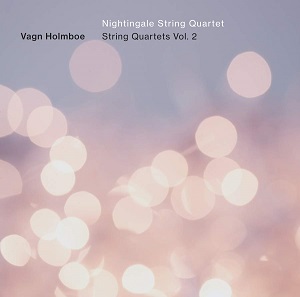
Vagn Holmboe (1909-1996)
String Quartets – Volume 2
String Quartet No. 2, Op. 47 (1949)
String Quartet No. 14, Op. 125 (1975)
Quartetto sereno, Op. 197 (op. posth.) ed. Per Nørgård (1996)
Nightingale String Quartet
rec. 2020, Studiescenen, Royal Danish Academy of Music, Copenhagen
DACAPO 6.220717 SACD [56]
Dacapo’s first Holmboe String Quartet cycle, played by the Kontra Quartet, was recorded between 1992-2000 and has been very handily summed up by Rob Barnett (review). The first volume in the label’s new series of the quartets (review), now heard in SACD, contained quartets 1, 3 and 15, and is in the hands of the Nightingale Quartet, stars of the Langgaard Quartet discography (see review). As before, early and late quartets form this second volume.
They’ve selected No.2 from 1949, a five-movement work composed in memoriam for Bartók whose first movement opens with a lurching figure and moves through bars of unrest to a serene and beautifully argued close. Each of the movements is sharply characterised, such as the Andante with its nocturnal temperature through which an expressive line runs, and the central Scherzo, full of scurry and life. Played muted, the Adagio may only be three minutes long, but its compression is controlled and profoundly expressive, the Balkan Dance finale imbuing the work with a sinuous element before the resolute end.
A quarter of a century had elapsed by the time the Fourteenth Quartet appeared, in 1975. A six-movement work lasting 21 minutes in this recording it shows the fluency of Holmboe’s conception. The opening – played muted – functions as a quasi-fantasia that runs into a deft, spry Scherzo-like Presto leggiero. Much here is light, clear, bracing and elegant but also withdrawn in the slow movement – a kind of sensuous austerity marks out the writing though Holmboe also unleashes pizzicati and a con spiritio finale, exuberant, fresh conjoining all affirmative elements in hopeful drive.
In 1991, five years before he died, Holmboe and his erstwhile student Per Nørgård, who had been somewhat estranged for many years, reconciled. It was clearly Holmboe’s wish that the pupil who had first studied with him privately in 1949 – and to whom he had dedicated the Quartet No.4 – should complete his 21st Quartet, the Quartetto sereno, of which only the opening movement had been completed by the time of Holmboe’s death. Cast in arch form the initial gravity moves to a state of agitation, thence returning to its opening. Nørgård based the second and final movement on Holmboe’s sketches, employing pizzicati freely, in an act of artistic co-creation, marking a fitting end to this cycle.
We are in a very fortunate position in having the Kontra Quartet’s cycle secure in the discography. They premiered the Quartetto sereno in 1997 and it has an honoured place in their cycle. They are slower and tonally denser in each quartet than the lighter-voiced and more malleable Nightingale Quartet. If this vests the Nightingale with a greater fluidity, it remains the case that the Kontra can be more generously expressive. Both quartets – so far so good with the Nightingale in their ongoing cycle – honour Holmboe in their own way and I wouldn’t be without either. Sorry, but that’s the way it is.
Jens Cornelius has written the perceptive notes and the recording in the Studiescenen, Royal Danish Academy of Music in Copenhagen, is excellent.
It’s not the sheer number of quartets that Holmboe wrote that mark out his cycle as one of the century’s finest. It’s the variety of expression, the changing and mutating nature of his design, and the superiority of his conception. These are some of the elements that draw in the admiring listener. Other composers provide more obviously torrid examples, expanding the quartet to quasi-orchestral proportions, but few are more truthful or more focused than Holmboe and few cycles mirror a creative life with such humanity.
Jonathan Woolf
Help us financially by purchasing from





















